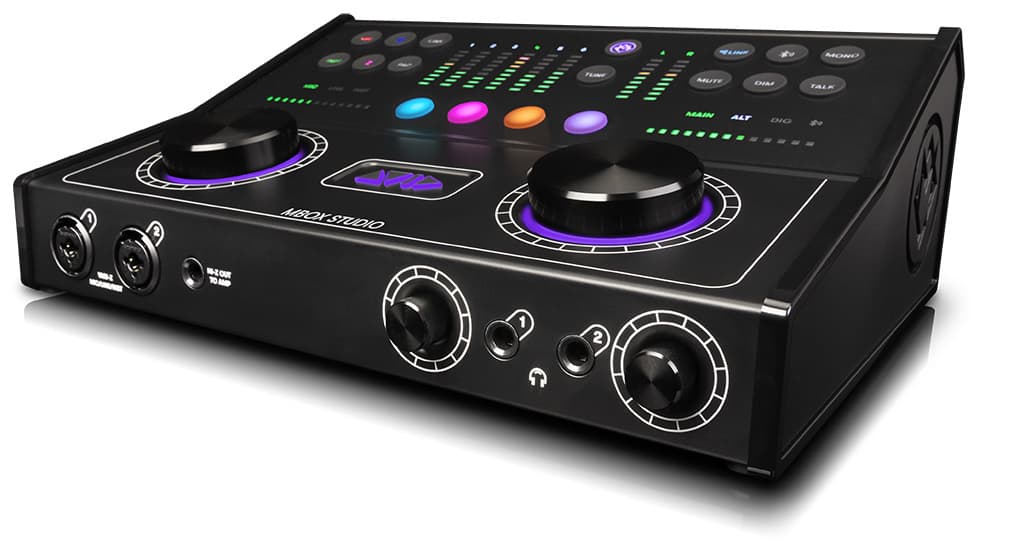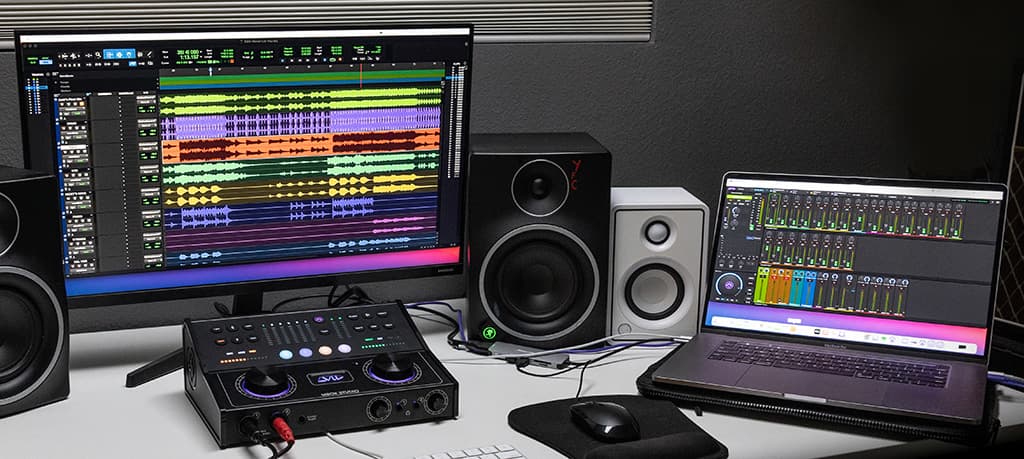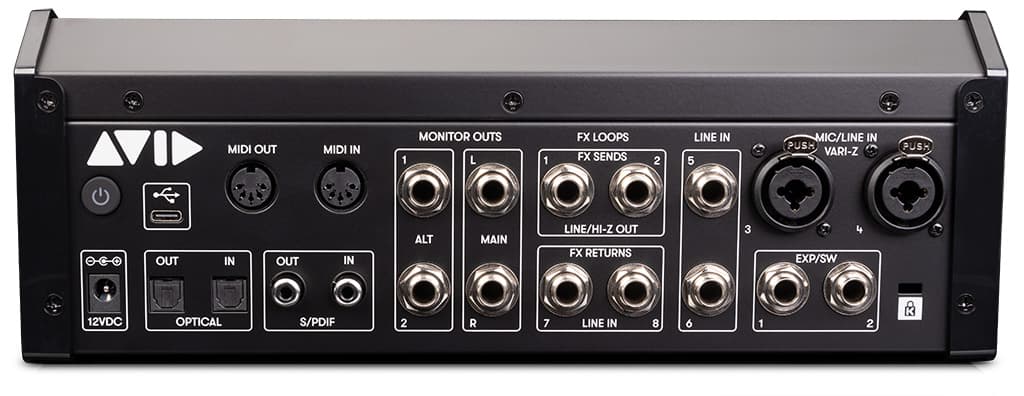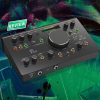
Review: Avid MBox Studio
A new take on the simple desktop box with a sophisticated in-the-box solution.
Review: Graeme Hague
Since its introduction in 2002, the design of the first MBox and its subsequent successors has always been about simple USB ‘boxes’. These came with enough connectivity to provide entry-level access to the world of Pro Tools, and Avid recognised that home studio enthusiasts were a viable market. Avid felt that having them start out with a trimmed-down version of Pro Tools and an MBox, or a Fasttrack interface, might lead to bigger and better things. The units were tough, portable, and reliable — I still have a Fasttrack Duo that always works regardless of the varied Windows OS and obsolete drivers on my laptop.
For those of us who have been around a while, don’t be duped by the MBox moniker. This isn’t a glorified Pro Tools dongle, it’s much more.
FINGERS & TOES
The MBox Studio manages to shoehorn in an I/O count of 21 inputs and 22 outputs. Aside from the four Variable Z mic/line inputs — which are important for many users — there are TRS line inputs, and ADAT optical ports giving you 8 channels each way. Then there’s MIDI, a sneaky TRS output on the front panel offering a convenient re-amp connector, and, more interestingly, Bluetooth in and out. Finally, there’s a talkback microphone, which is also connected to a guitar tuner, but what gets a big thumbs-up from me are the two separate headphone outputs with individual volume controls.
The layout and workflow of the MBox Studio provide a cool diversion from the norm. Two large rotary controllers allow the adjustment of everything, depending on parameters chosen by a bank of buttons. The concept isn’t too dissimilar to a live mixing console — where you first need to choose what you’re tweaking before a single controller can dial in the changes — albeit in a scaled down way.
The Studio is essentially split down the middle with the left controller handling Input parameters, while the right rotary dial deals with Output settings. Both have push-button operation to cycle through options. The legending and backlighting of the interface provides clarity — there’s never any confusion about what you’re doing. Four assignable hotkeys can be configured to access most functions (although not as Transport controls) and are given a dedicated colour. These are dual-purpose, where a single, short or long press can trigger different uses.
Still a desktop model, and larger than its predecessors, it requires USB-C to a computer and the included power supply. The wedge-shaped profile that allows the space needed for its wealth of hardware connectors at the rear has the MBox Studio looking like a mini console.
NEED TO KNOW

WHAT’S IT ALL ABOUT?
Most desktop audio interfaces are intended to be entirely subservient to the host DAW. Not so the MBox Studio.
The MBox Studio Control software gives you such complete control and DSP processing of your inputs and monitoring that the DAW activity (whether that be Pro Tools or another platform) is often just happening in the background. Aside from playback of the existing session tracks, the Studio can provide almost everything you need for real-time, latency-free tracking. Usually, there’s a bit of to-and-fro between the interface software and the DAW session to create the ideal recording environment in the headphones or monitors. Instead, the Control software has nearly everything covered. Before worrying about the business of tracking, you can work within this GUI exclusively — ignoring the DAW window — while getting your monitoring sounding perfect.
Okay, I’ve said ‘almost’ and ‘nearly’, and that’s because the Control GUI lacks a fully functioning compressor on the inputs. This is something that immediately raised a few questions in the Pro Tools community, however you can always punch in the soft limiter instead.

COMFORT ZONE
On every MBox Studio input, inside the Control software, is a channel strip-like interface where you can fine-tune your source signal. Most on/off functions are also accessible via the buttons on the interface, but the software GUI makes things more obvious. There is a Pad, HPF, that soft limiter, and a polarity switch. Your 48V phantom power is provided individually to each channel, and you can choose between mic/line/instrument inputs — although this is also automatically determined by what has been plugged in. A variable Z impedance setting gives you the exact values of the seven options, whereas the hardware buttons will only display different colours to indicate different values. Gain and pan controls are there too, along with mute and solo. Off to one side is an Avid FX Send that feeds two global effects engines with reverb and delay, the latter maxing out at 320ms. These can be bypassed individually if any input doesn’t require anything.
Below all of that is a four-band parametric EQ which can be similarly bypassed, and also offers the option to ‘EQ to DAW’, meaning your track can be printed with EQ (or not). Bottom line: you can configure the perfect headphone mix, including EQ and any effects that puts the artist in their comfort zone, while your tracked signal is raw and untouched. Given that this is all done in-the-box, your DAW’s CPU isn’t troubled by any of it. All that’s left to do now is put together a mix of your MBox Studio inputs.

ENTER THE MATRIX
Here’s where you really need to keep your thinking cap on. For every hardware input (21 of them) there is a fader that controls the send level to each of the 22 outputs. Further to that, in between this are eight ‘internal’ software inputs (each with its own fader) to control the levels to each output. The internal software inputs are the available buses inside your DAW. As long as they’re assigned to a bus you can adjust the monitor levels of separate tracks in your session — keeping in mind that your Internal Software Inputs 1 & 2 are your Main Outs by default.
Initially, the matrix can feel intimidating. But if, for example, you choose the second headphone output as your destination, you have the ability to create a bespoke additional monitor mix — which is pretty darn cool. There are, of course, plenty of other potential applications. By the way, you can save that matrix configuration as a preset.

PLAY IT AGAIN SAM
Who needs amp sims when the Line 7 output is what Avid is calling the ‘Re-Amp’ port? This ‘Hi Z to Amp’ 6.25mm TRS output on the front of the interface is a thoughtful addition, and able to send a guitar track back out to that battered Fender Reverb Twin you’ve got mic’ed up in the corner. Obviously, it doesn’t have to stop there. I imagined sending a vocal signal to a hardware harmoniser or any kind of outboard processor. Again, it’s not ground-breaking, but the ease-of-use is very handy. The Bluetooth connections are touted as a means to check your mixes through domestic sound systems, but I immediately thought of a third headphone choice.
THINKING OUTSIDE THE MBOX
The MBox Studio offers users the best of both worlds, and then some. The convenience of its design and its smaller footprint are deceptive as to what it is really capable of. This is a powerful and well-featured device that’s deservedly in the upper echelon of DAW interfaces. If you’re more accustomed to a black on black colour scheme with perhaps one blue LED near the on/off switch then this product might initially present as less-than-professional. Don’t be swayed, the quality of the build and the components are excellent.
To get the best out of the MBox Studio then you need to spend less time looking at your DAW UI and more time in the Control GUI. For many, this will take some getting used to. The MBox Studio comes with a one-year subscription to Avid’s Pro Tools Studio version, a one-year subscription to Sibelius Artist, and a bundle of additional software on top of the 115-plus AAX plug-ins already included with the Pro Tools subscription. The interface is designed to work with older versions of Pro Tools (and other DAWs) so if you’re only looking to upgrade that trusty MBox or Fasttrack box, you’re good to go.
MBox Studio isn’t yet another audio interface. It’s a departure with plenty to commend it. I’ve no doubt it will appeal to seasoned Pro Tools professionals (perhaps for an edit room or second production suite) and to the more serious prosumer market.



























RESPONSES